
12-3 #Codes : TSMC’s fab in Arizona will begin producing 4nm chips as soon as it opens in 2024; Samsung has removed BOE from its official suppliers’ list; OnePlus says it is committing to a 4-year plan for OS updates and a 5-year plan for security updates; etc.

Global semiconductor revenue is projected to decline 3.6% in 2023, according to the latest forecast from Gartner. In 2022, the market is on pace to grow 4% and total USD618B. Currently, the semiconductor market is polarized between the consumer-driven markets and enterprise-driven markets. Weakness in the consumer-driven markets is being driven largely by the decline in disposable income caused by rising inflation and interest rates, but also by the reprioritization of consumer discretionary spending to other areas such as travel, leisure and entertainment, which are having a negative knock-on effect on technology purchases. (Neowin, Gartner)

The United States has been a leader in microchip design with dominant companies like Nvidia, Intel and Qualcomm, but it risks a big drop in global market share without government support for the sector. The U.S. share of chip design revenue has been slipping in recent years, dropping to 46% in 2021 from over 50% in 2015. Without government support, that could drop to 36% by the end of this decade, according to the analysis released by U.S. industry body Semiconductor Industry Association (SIA) and Boston Consulting Group. The United States has already lost its lead in chip manufacturing, prompting the Biden administration to pass the CHIPS and Science Act in 2022. An earlier report by SIA and BCG in 2020 showed the U.S. share of modern global chip manufacturing capacity had fallen to 12% by that year, down from 37% in 1990. (SIA, SIA report, Reuters)
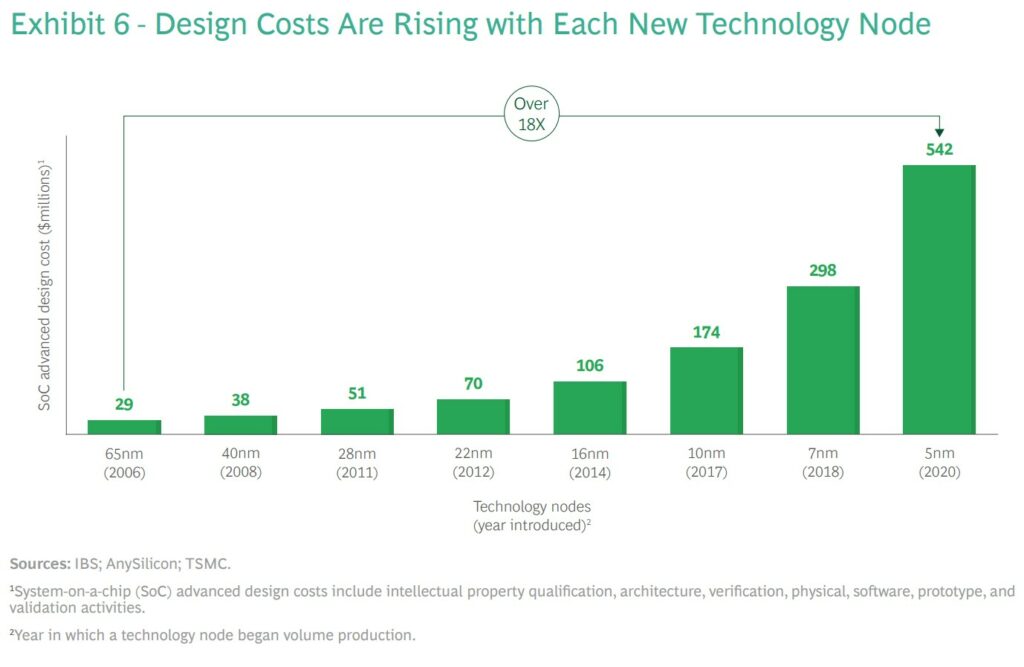
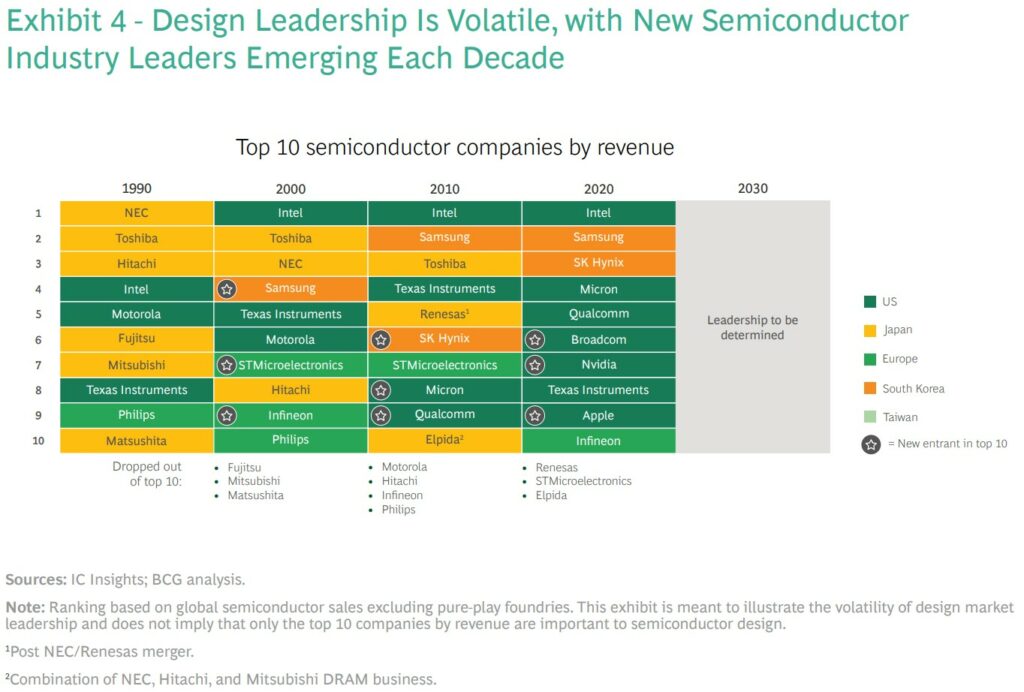
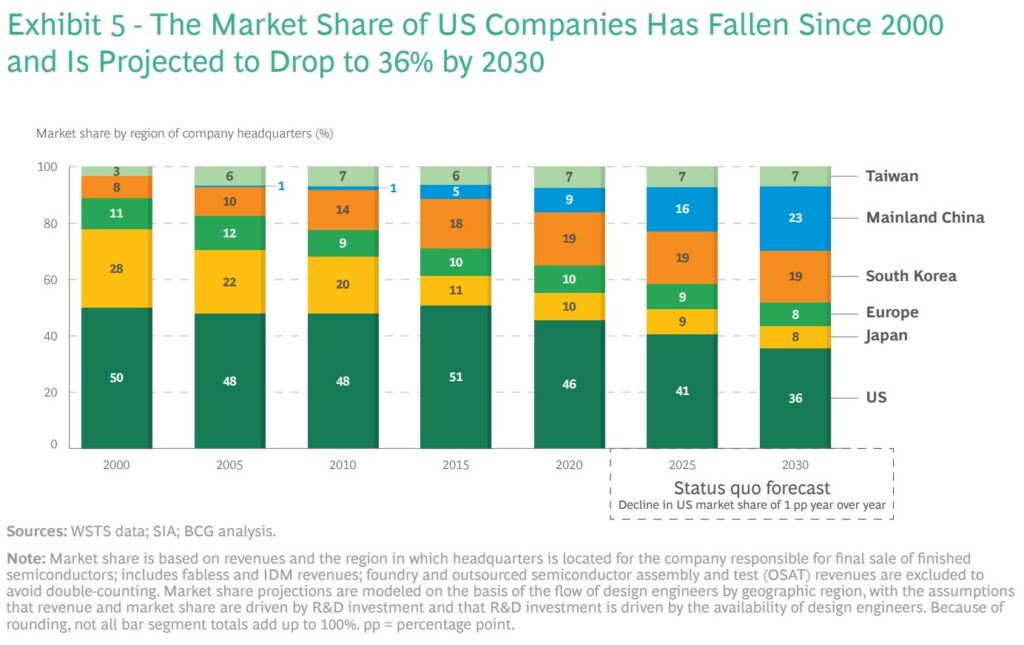
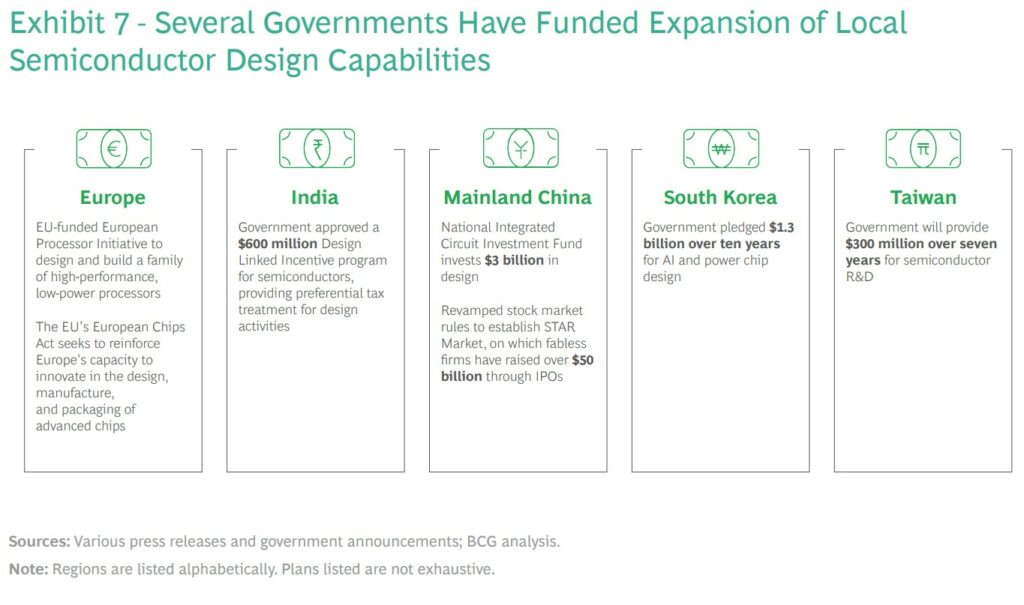
GlobalWafers has broken ground on a major plant in Texas to make 300mm wafers, a key part of the silicon supply chain. The 3.2M square feet megafactory in Sherman, Texas, is the first silicon wafer factory built in the United States in over 20 years and will address the critical shortage in US domestic supply of silicon. This wafer supply has fallen to less than 1% of demand, with the vast majority coming from Taiwan. GlobalWafers looked to acquire Siltronic in Germany to boost its wafer production capacity, but that deal was opposed by regulators. As a result the company looked to the US.(Laoyaoba, Digitimes, Forbes, EE News Europe)

TSMC’s USD12B chip plant currently under construction in Arizona will begin producing 4nm chips as soon as it opens in 2024 thanks to urging from Apple and other companies, according to Bloomberg’s Mark Gurman. The plant had originally been planned to start with production of 5nm chips, but with Apple and other companies increasingly looking to source components from the United States, TSMC has upgraded its plans so the facility will be able to supply more cutting-edge chips. In addition to the 4nm production facility, TSMC will reportedly officially announce plans for a second phase involving an adjacent facility that will produce even more advanced 3nm chips, a development that was revealed by TSMC founder Morris Chang.(MacRumors, China Times, Yahoo, TechNews, UDN, BGR, Bloomberg)

Samsung Electronics has announced the number of Galaxy Z Fold and Galaxy Z Flip smartphones sold for enterprise use has more than doubled YoY. From Jan to Oct 2022, the number of foldable smartphones Samsung contracted to enterprise customers increased by 105% compared to the same period in 2021. With foldable smartphone shipments expected to reach 16M units worldwide — an increase of 73% YoY — the form factor is rapidly becoming mainstream, and shipments are expected to grow to 26M units in 2023. (GSM Arena, Samsung)
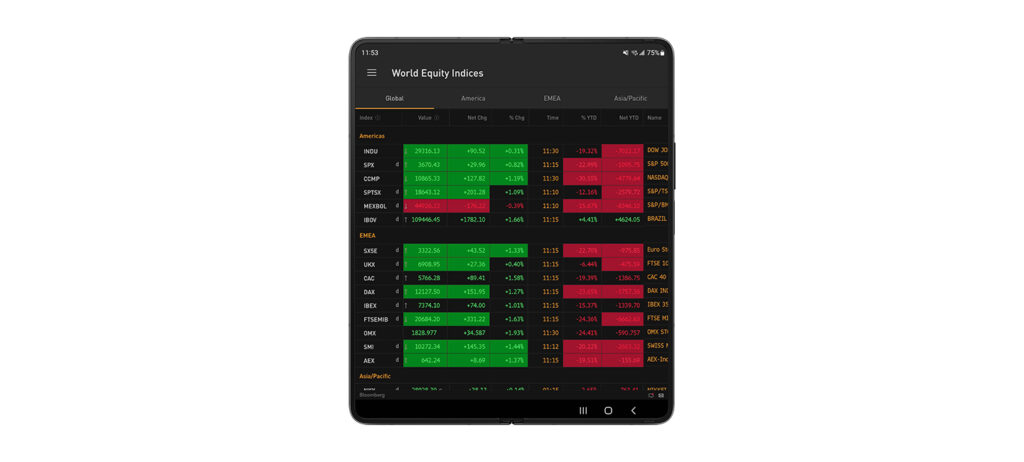
Corning Incorporated has unveiled its newest glass innovation, Corning Gorilla Glass Victus 2. Corning continues to push the boundaries of glass by expanding its Corning Gorilla Glass portfolio. In lab tests, Gorilla Glass Victus 2 survived drops of up to 1m on a surface replicating concrete. Competitive aluminosilicate glasses from other manufacturers typically failed when dropped from half a meter or less. In addition, Gorilla Glass Victus 2 continued to survive drops up to 2m on a surface replicating asphalt and maintained scratch resistance up to 4 times better than competitive aluminosilicate. (GSM Arena, Corning)
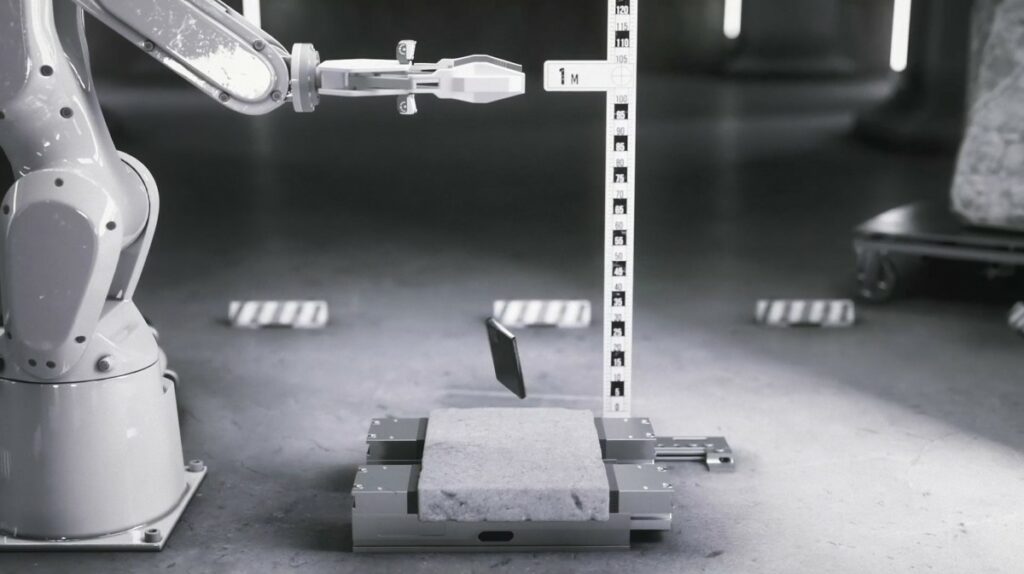
The adoption of the OLED display technology among smartphones is on a gradual rise. According to TrendForce’s latest research, the penetration rate of smartphones that feature an OLED panel (regardless of whether the OLED panel is the rigid, flexible, or foldable type) is projected to climb from around 47.7% in 2022 to 50.8% in 2023. Then, by 2026, the penetration will climb above 60%. TrendForce points out that Chinese smartphone brands previously did not actively widen the adoption of flexible OLED panels on account of two factors. First, Samsung Display (SDC) had been able to sell rigid OLED panels to Chinese brands at lower prices because it is the sole supplier for this type of panel. And because of favorable prices, Chinese brands preferred rigid OLED panels as they helped bring down the cost of a whole device. Second, concerns about whether consumers can accept higher prices for their devices also affected Chinese brands’ willingness to use flexible OLED panels. (My Drivers, TrendForce, TrendForce)
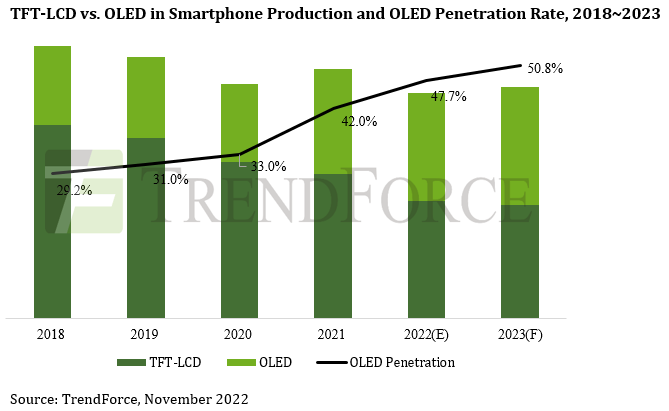
According to DSCC, in 3Q22, OLED panel income decreased by 11% YoY, and panel shipments decreased by 17% YoY. In 3Q22, smartphones are still the largest OLED proportion applications, accounting for 68% of OLED market share and 75%panel income share, but below 2Q22, respectively. OLED smart watches accounted for 23% of the market share and 9%income share, which are higher than 2Q22, respectively. The unit share of OLED TV is 1% and the income share is 9%. In 3Q22, in the purchase of OLED smartphone panels divided by the brand, Apple’s share increased from 29% of 2Q22 to 45%, followed by Samsung’s market share of 17%, below 23% of 2Q22. In 3Q22, the rigid OLED smartphone surface has dropped by 41% MoM, and the flexible OLED smartphone panel is 9%in quarterly. (Laoyaoba, DSCC, DSCC, OLED-Info)
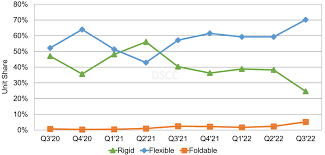
Samsung has removed BOE from its official suppliers’ list, which means that the company will not buy any products from the Chinese firm. This is due to recent royalty payment issues from BOE. Samsung has reportedly requested BOE to pay royalty fees for using Samsung’s name in its marketing, but BOE has declined. Since then, Samsung has reduced buying display panels from BOE. BOE’s OLED panels are usually used in Samsung’s affordable and mid-range smartphones, while LCD panels are used in the company’s affordable TVs. Now, the company has increased orders to buy display panels from CSOT and LG Display.(Laoyaoba, Android Headlines, SamMobile, The Elec)
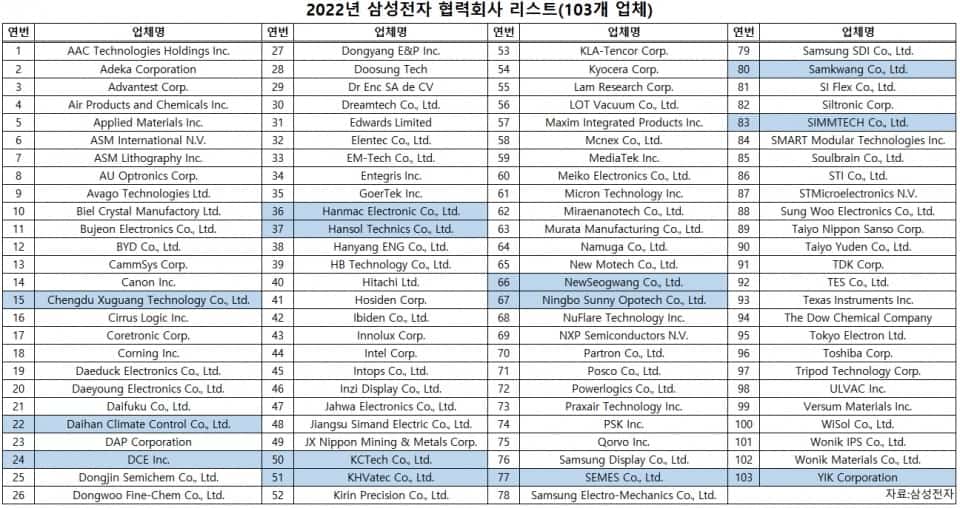

High performance, high capacity and high bandwidth memory solutions are helping bring the virtual realm to a closer match with reality. To meet this growing market demand, Samsung Electronics has developed GDDR6W (x64): the industry’s first next-generation graphics DRAM technology. GDDR6W builds on Samsung’s GDDR6 (x32) products by introducing a Fan-Out Wafer-Level Packaging (FOWLP) technology, drastically increasing memory bandwidth and capacity. In Jul 2022, Samsung developed a 24Gbps GDDR6 memory, the industry’s fastest graphics DRAM. GDDR6W doubles that bandwidth (performance) and capacity while remaining the identical size of GDDR6. (My Drivers, Neowin, Samsung)
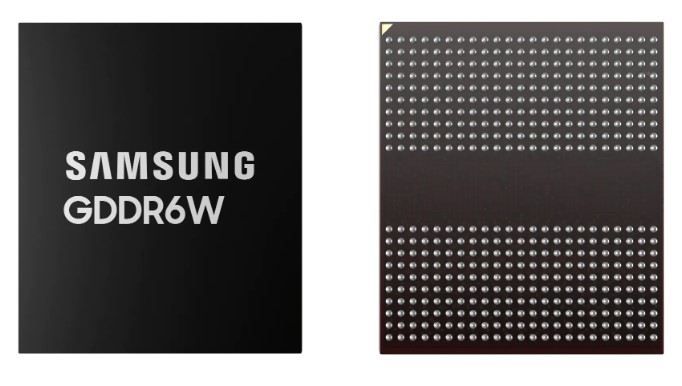

Sony has announced Mocopi, a portable and lightweight motion capture system that can be used to control a digital avatar in real time within metaverse applications like VR Chat. The kit consists of 6 button-like tracking tags — one for head, hip, both ankles, and both wrists — that use Bluetooth to pair with an Android or iOS smartphone app to input motion data to compatible services like Unity. The Mocopi sensors measure 32mm (around 1.2 inches) in diameter and weigh just 8g. Sony is also releasing a software development kit (SDK) that links motion capture data with metaverse services and 3D development software, such as Unity and Autodesk MotionBuilder.(Engadget, Sony, The Verge)
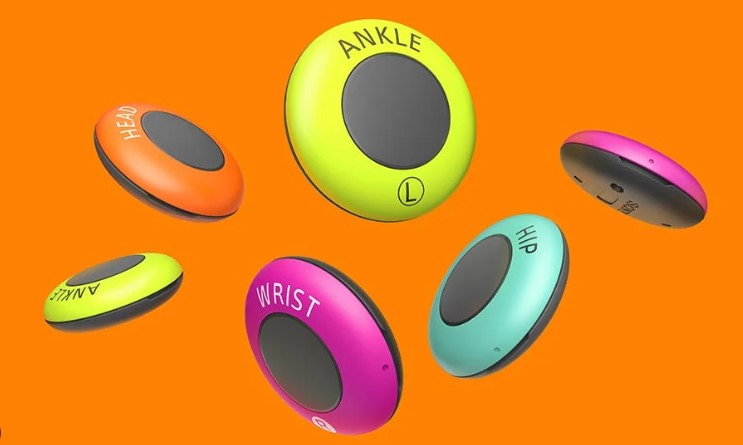
Tesla’s CEO Elon Musk expects a wireless brain chip developed by his company Neuralink to begin human clinical trials in 6 months, after the company missed earlier timelines set by him. The company is developing brain chip interfaces that it says could help disabled patients to move and communicate again, with Musk adding it will also target restoring vision. Based in the San Francisco Bay Area and Austin, Texas, Neuralink has in recent years been conducting tests on animals as it seeks approval from the U.S. Food and Drug Administration (FDA) to begin clinical trials in people.(Engadget, Reuters, CNBC, CNET)


Dieter May, the CEO of ISORG, a French company that focuses on smartphone fingerprint sensing and other technology, has recently revealed that Samsung is working on multi-fingerprint sensing displays. He also said that Samsung appears to be interested in making the entire screen capable of fingerprint reading. In Sept 2022, Samsung announced that it is working on next-generation OLED displays. These “OLED 2.0” screens would have an all-in-one fingerprint scanning solution that would enable the device to scan multiple fingerprints simultaneously. Three fingerprints is 2,500,000,000 times more secure for authentication than using a single fingerprint. In addition to having the ability to sense multiple fingerprints, having an entire screen that’s capable of scanning would mean that users no longer have to worry about where they are placing their fingers. There is no official word from Samsung on when these new displays might come, but May says that his company predicts that Samsung will likely be ready to deliver sometime in 2025. (Android Authority, OLED-Info, YouTube)
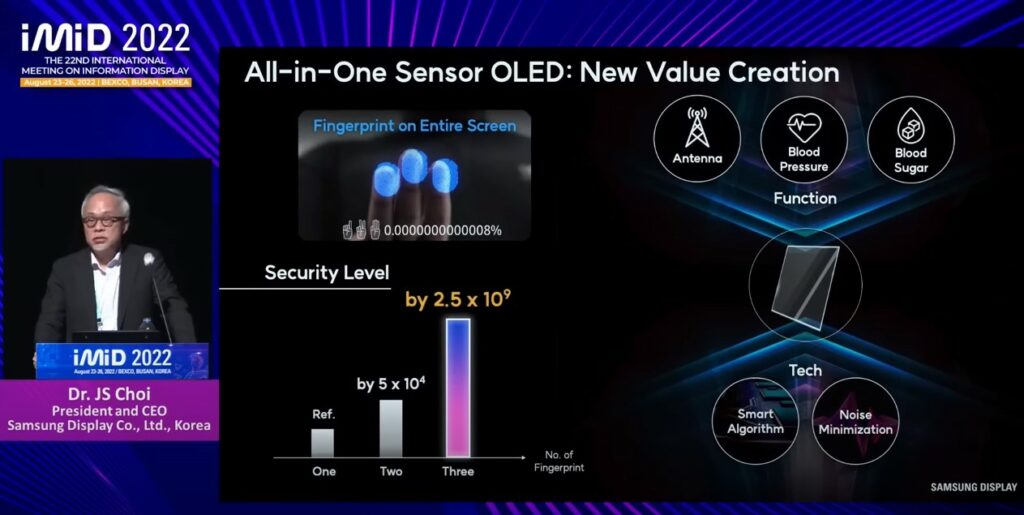

Samsung has has filed paperwork to trademark “Samsung Superfast Portable Power”. As per the classification, the trademark term may be used for “Battery chargers for mobile devices; battery packs for mobile devices”.(My Drivers, Phone Arena, SamMobile, TM View)
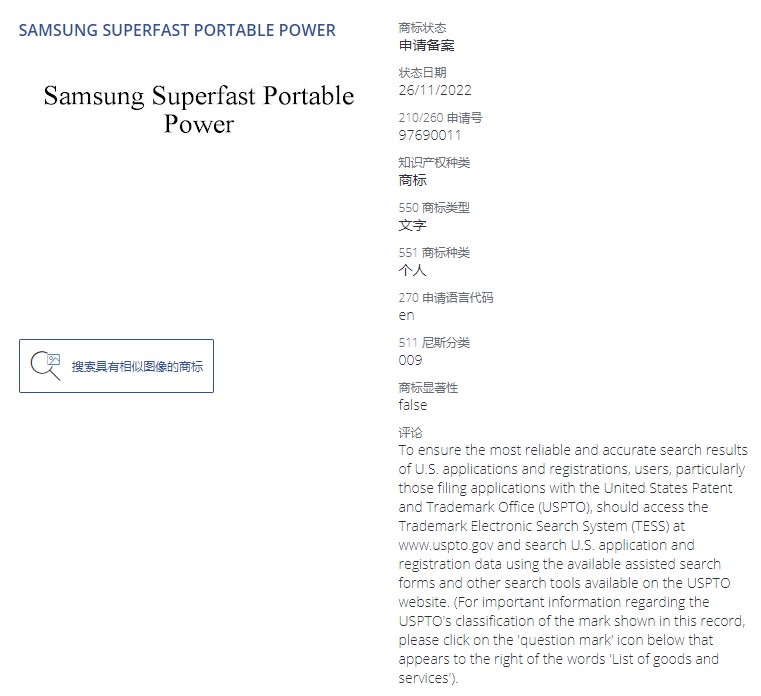
Battery-swapping technology company Gogoro is adding the Philippines to its operations. Gogoro’s domestic operations in Taiwan have seen up to 350M battery swaps. The company has invested substantially in the development and improvement of its battery-swapping technology. The swapping technology has gained traction over the past few years with up to 12 non-Gogoro e-scooters using the system. Gogoro continues to expand its battery-swapping operations through strategic partnerships with local e-scooter brands. The pilot battery swapping scheme will kick off in Manila by 1Q23. (Gizmo China, Electrek)

Airbus has revealed that it is developing a hydrogen-powered fuel cell engine. The propulsion system is being considered as one of the potential solutions to equip its zero-emission aircraft that will enter service by 2035. Airbus will start ground and flight testing this fuel cell engine architecture onboard its ZEROe demonstrator aircraft towards the middle of the decade. The A380 MSN1 flight test aircraft for new hydrogen technologies is currently being modified to carry liquid hydrogen tanks and their associated distribution systems.(Engadget, Airbus)

Rolls-Royce and easyJet have confirmed they have set a new aviation milestone with the world’s first run of a modern aero engine on hydrogen. The ground test was conducted on an early concept demonstrator using green hydrogen created by wind and tidal power. It marks a major step towards proving that hydrogen could be a zero carbon aviation fuel of the future and is a key proof point in the decarbonisation strategies of both Rolls-Royce and easyJet. The partnership is inspired by the global, UN-backed Race to Zero campaign that both companies have signed up to, committing to achieve net zero carbon emissions by 2050.(Gizmo China, Rolls-Royce)
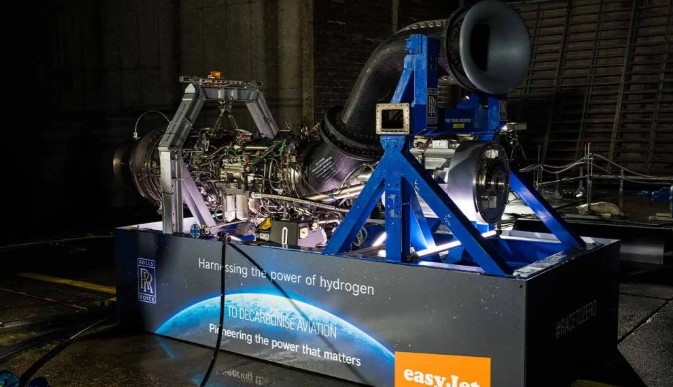

Samsung is planning to invest INR400 crore (USD49M) in its manufacturing facility in Kanchipuram, Tamil Nadu, India, to make 4G and 5G telecommunications infrastructure equipment. Samsung Networks will now join Ericsson and Nokia in local manufacturing in India. With this investment, Samsung can apply for India’s Production Linked Incentive (PLI) scheme, which offers incentives 4-7% to encourage local electronics manufacturing. Samsung has already received the Indian government’s (National Security Council Secretariat) approval as a trusted source of telecom equipment. Samsung Networks has already received orders from two biggest telecom operators in India: Bharti Airtel and Reliance Jio.(Gizmo China, SamMobile, India Times)
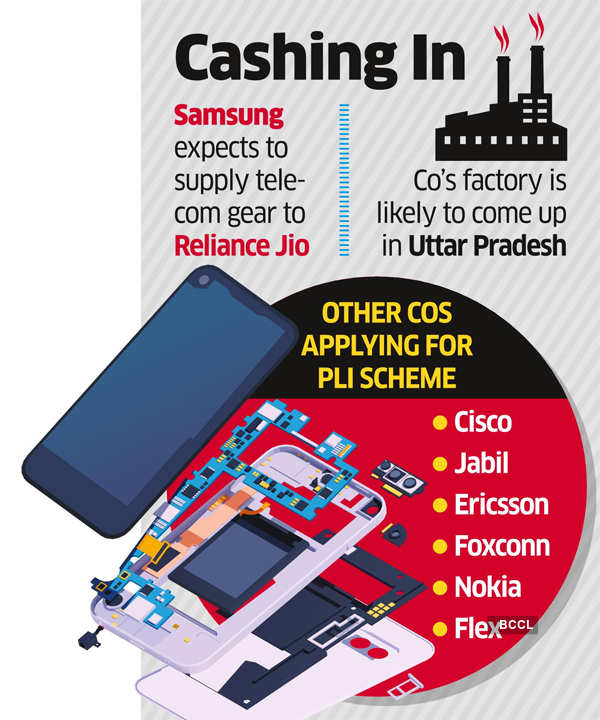
Chinese ZTE and the country’s Ministry of Industry and Information Technology (MIIT) have conducted a sample test of some technologies that will be important for the creation of 6G. ZTE provided some of the staff and equipment used in the tests. The five tests that ZTE took part in included: 6G distributed autonomous network and digital twin network concept sample, 6G computing power network key tech concept sample, 6G terahertz key tech concept sample, 6G communication perception integration key tech concept sample, and 6G intelligent metasurface tech concept sample. In 2021, the China National Intellectual Property Administration (CNIPA) claimed that out of approximately 38,000 patents related to 6G worldwide, 13,449, or 35% came from China. The U.S. was second with 18% of the 6G patents. (Gizmo China, Phone Arena, GizChina, IT Home)
British smartphone maker Bullitt Group says it will launch “the world’s first smartphone to include two-way satellite messaging technology” in early 2023. Bullitt also says its phone will rely on a new MediaTek 3GPP NTN (Non-Terrestrial Network) chipset for satellite functionality. The software in the device knows whether the phone is connected to Wi-Fi or cellular and will only send messages over satellite when neither of the traditional messaging connections is available. (Liliputing, PC Mag, Bullitt)
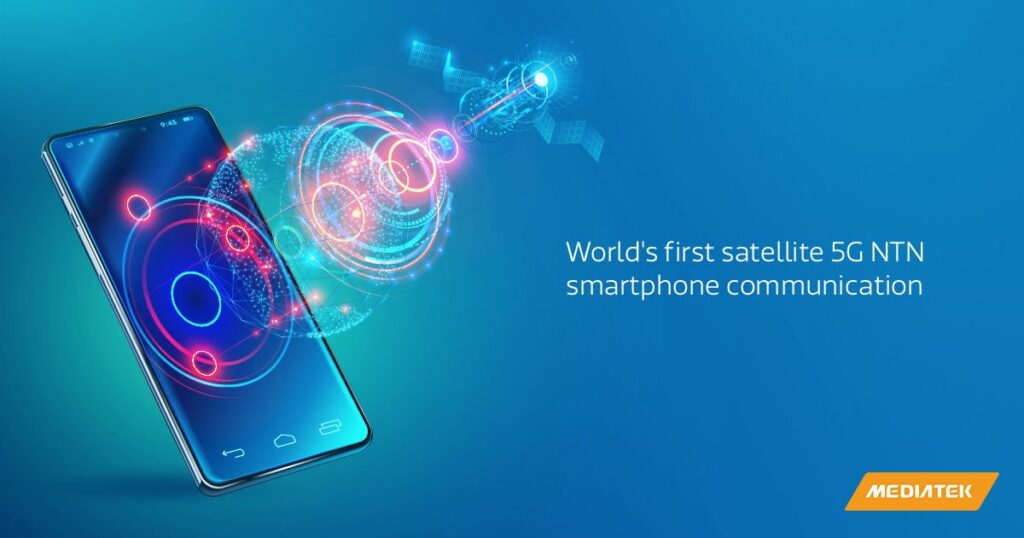

According to TF Securities analyst Ming-chi Kuo, the production of the Zhengzhou Apple iPhone plant was significantly affected by laborers’ protests, so I cut the 4Q22 iPhone shipments by about 20% to 70–75M units (vs. the market consensus of 80–85M units). The total iPhone 14 Pro and 14 Pro Max shipments in 4Q22 will be 15–20M units less than expected. The average capacity utilization rate of Zhengzhou iPhone plant was only about 20% in Nov 2022, and it is expected to improve to 30–40% in Dec 2022. Pegatron and Luxshare ICT have obtained about 10% of the iPhone 14 Pro and 14 Pro Max orders from Foxconn, respectively. But mass shipments will not be until late Dec 2022 at the earliest. (GSM Arena, Medium, Medium, Twitter)
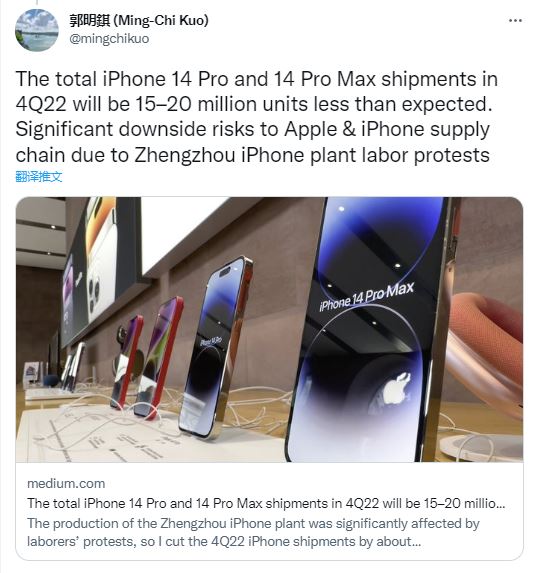
According to Bloomberg, turmoil at Apple’s key manufacturing hub of Zhengzhou is likely to result in a production shortfall of close to 6M iPhone Pro units. Much will depend on how quickly Foxconn Technology Group, the Taiwanese company that operates the facility, can get people back to assembly lines after violent protests against Covid restrictions. If lockdowns continue in the weeks ahead, production could be set further back. (GSM Arena, Bloomberg, Twitter)
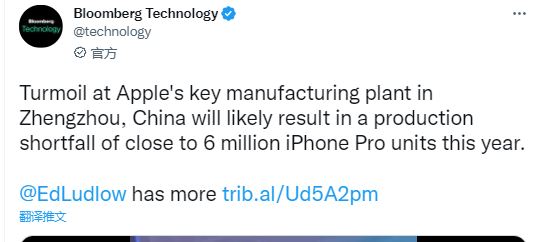
Google Webmaster trend analyst, Gary Illyes has said that 60% of the content on the Internet are duplicates. According to Google, “Duplicate content generally refers to substantive blocks of content, within or across domains, that either exactly matches or are clearly similar to other content”. Therefore, for the sake of search engine optimization (SEO), a website should have to avoid using such content. Instead, they can provide their own unique content. Google has since confirmed that it is working on a tool that will allow Android users to “archive” some apps. This will help users to create some space in the device. According to Google, up to 60% of a device’s memory can be available by simply using an app archive.(GizChina, Digital Information World, Twitter)
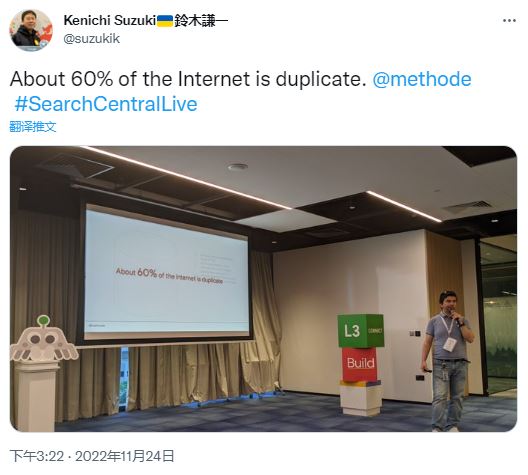
Samsung has filed a trademark application for the name Self Repair Assistant. According to the accompanying documents, the product is a mobile app providing “consultancy and information services” for “self-installation, self-maintenance, and self-repair” of smartphones, smartwatches, tablets, and earbuds. The app’s icon features a wrench inside a gear on a blue background with rounded corners.(Android Headlines, TM View, SamMobile)
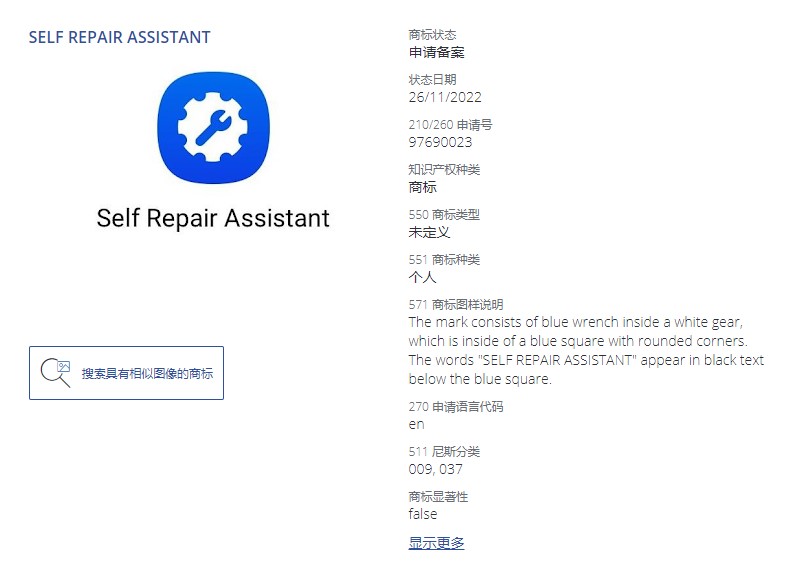
OnePlus says it is committing to a 4-year plan for OS updates and a 5-year plan for security updates. The company plans on launching Oxygen OS 13.1 globally staring in 1H23. Oxygen OS 13.1 will bring a number of features like an AI system booster, dynamic always on display, spatial audio, and more.(Neowin, Android Authority, Digital Trends)

Despite inflation and geopolitical crises that have continued since the beginning of 2022, the global smartwatch market shipments increased 30% YoY in Q3 2022, according to Counterpoint Research. Apple grew 48% YoY thanks to strong sales of its newly released Apple Watch 8 series. Released in early September, the new series accounted for about 56% of the overall shipments. Apple accounted for about half of the market among HLOS smartwatches in 3Q22. However, this was a slight decrease from the 54% share in Q2 2022 due to the slump in North America and Europe, which are major markets. India’s smartwatch market grew 171% YoY in Q3 2022 to become the biggest market in the world. Note: HLOS Smartwatch is defined as electronic watch running a high-level OS, such as Watch OS (Apple) or Wear OS (Samsung), with the ability to install third-party apps. (Phone Arena, Counterpoint Research)
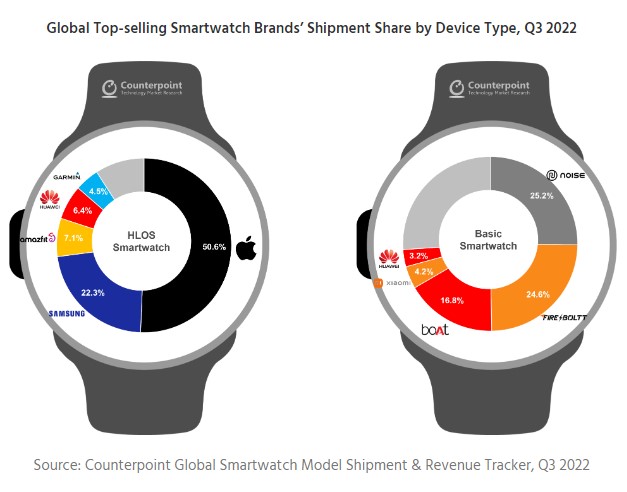
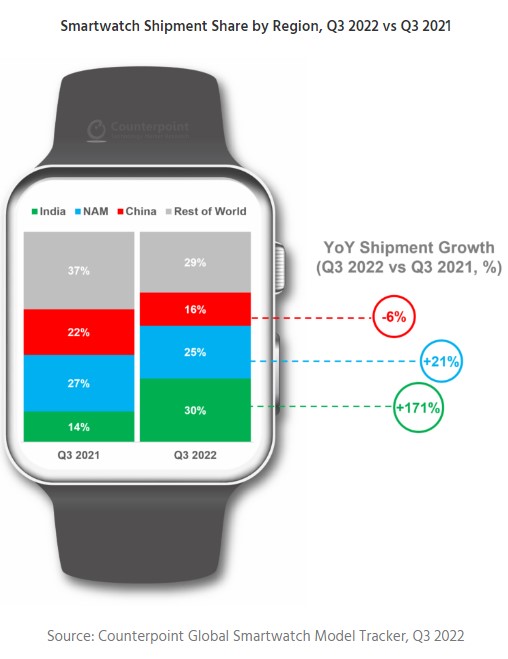

South Korean and Chinese companies are amassing patents for metaverse hardware, with LG Electronics and Huawei Technologies climbing the ranks as the electronics sector looks beyond the smartphone. The global metaverse market is on track to reach USD74.7B in 2026, a fivefold increase in 5 years, according to IDC. LG Electronics submitted the most metaverse patent applications since 2016, climbing from 11th for 2010-2015, according to a ranking tabulated by Nikkei and survey company Cyber Creative Institute. Samsung Electronics held its position in second. Display color schemes and semiconductors are among the strengths of the South Korean companies, which have rapidly gained a presence in core components rather than headsets and other finished products. (Gizmo China, Entrepreneur, Nikkei, India Times)
Ireland’s Data Protection Commission (DPC) has announced that it has imposed a fine of EUR265M on Meta’s Irish subsidiary. The reason is a 2021 data breach on Facebook that exposed the phone numbers, locations, and birthdates of 533 million people who were Facebook users from 2018 to 2019. The DPC started its investigation into the matter on 14 Apr 2021, following media reports about the discovery of this dataset, which was being made available on the internet. The inquiry concerned questions of compliance with the EU’s GDPR obligation for “Data Protection by Design and Default”, which Meta was found guilty of not adhering to. (GSM Arena, Data Protection, The Verge)

Cruise, GM’s self-driving technology subsidiary, has started the long and winding regulatory process to test its next-generation “Origin” robotaxi on public roads in San Francisco. The company has applied for a permit with the California Department of Motor Vehicles to test its custom-built driverless vehicle on public roads. Cruise is already charging the public for rides in its autonomous Chevy Bolt EVs in certain parts of San Francisco after receiving all the required permits from the California DMW and the California Public Utilities Commission. (TechCrunch, WSJ)

Five years after they were first revealed, the first Tesla Semi trucks were delivered to customers at the company’s Gigafactory in Sparks, Nevada. The trucks, which were first unveiled in concept form back in 2017, were supposed to go into production in 2019 but were delayed for a variety of reasons, including the COVID-19 pandemic and a global parts shortage. Representatives from PepsiCo, which reserved 100 Semis shortly after its reveal, were on hand to receive the first batch of trucks. Tesla says the Semi is powered by four independent motors on the rear axles, can accelerate 0-60mph in 20 seconds, and has a battery range of up to 500 miles. Prices may start at $150,000, and there have been a number of orders from businesses like Walmart and FedEx in the low-dozens range. (Gizmo China, The Verge, Electrek, Tesla, CNN)
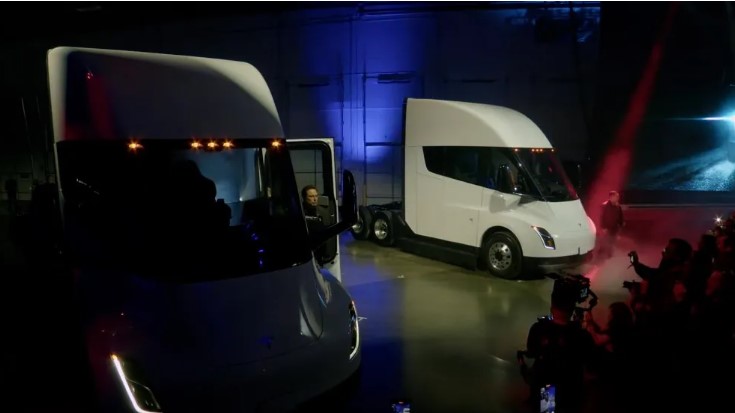

Spurred on by new legislation favorable to the cryptocurrency industry in South Korea, Samsung is in the process of designing its crypto exchange. The company will reportedly launch its own cryptocurrency exchange platform in 1H23. The project is in the hands of teams from the Samsung Securities division, who are working on the development of such a service, of course based on the blockchain. (GizChina, Medium, Newspim)